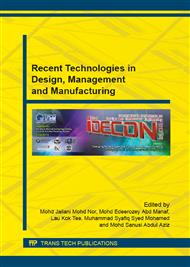p.3
p.8
p.12
p.17
p.22
p.27
p.32
p.37
Warpage Analysis of Different Number Cooling Channels for Dumbbell Plastic Part in Injection Moulding
Abstract:
Warpage deflection is one of the common pitfalls in plastic injection moulding which is always affected the quality and accuracy of the plastic products. It occurs due to the influences of mould temperature during injection moulding process and it is related to the number of cooling system existed in the mould. Therefore, this paper studies the effect of cooling channels on warpage of dumbbell plastic part having different number of cooling channel using Moldflow software. Warpage analysis was run using four and eight cooling channels. Parameters involved in this study are injection time, packing time, melt temperature and mould temperature. The result of warpage from simulation analysis was projected on the graphic having different colour which is presented the actual value of warpage. It is found from warpage simulation result that the maximum warpage for four cooling channels is 1.283mm and the maximum warpage for eight cooling channels is 1.280mm. It shows that the increasing of the number of cooling channel from four to eight channels in the injection mould reduces the warpage deflection about 0.2%. Thus, the result shows that the number of cooling system in the mould plays an important role on the quality of plastic part during injection moulding process.
Info:
Periodical:
Pages:
8-11
Citation:
Online since:
May 2015
Price:
Сopyright:
© 2015 Trans Tech Publications Ltd. All Rights Reserved
Share:
Citation:


